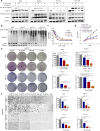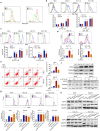Targeting proteasomal deubiquitinases USP14 and UCHL5 with b-AP15 reduces 5-fluorouracil resistance in colorectal cancer cells
- PMID: 37528233
- PMCID: PMC10692219
- DOI: 10.1038/s41401-023-01136-0
Targeting proteasomal deubiquitinases USP14 and UCHL5 with b-AP15 reduces 5-fluorouracil resistance in colorectal cancer cells
Abstract
5-Fluorouracil (5-FU) is the first-line treatment for colorectal cancer (CRC) patients, but the development of acquired resistance to 5-FU remains a big challenge. Deubiquitinases play a key role in the protein degradation pathway, which is involved in cancer development and chemotherapy resistance. In this study, we investigated the effects of targeted inhibition of the proteasomal deubiquitinases USP14 and UCHL5 on the development of CRC and resistance to 5-FU. By analyzing GEO datasets, we found that the mRNA expression levels of USP14 and UCHL5 in CRC tissues were significantly increased, and negatively correlated with the survival of CRC patients. Knockdown of both USP14 and UCHL5 led to increased 5-FU sensitivity in 5-FU-resistant CRC cell lines (RKO-R and HCT-15R), whereas overexpression of USP14 and UCHL5 in 5-FU-sensitive CRC cells decreased 5-FU sensitivity. B-AP15, a specific inhibitor of USP14 and UCHL5, (1-5 μM) dose-dependently inhibited the viability of RKO, RKO-R, HCT-15, and HCT-15R cells. Furthermore, treatment with b-AP15 reduced the malignant phenotype of CRC cells including cell proliferation and migration, and induced cell death in both 5-FU-sensitive and 5-FU-resistant CRC cells by impairing proteasome function and increasing reactive oxygen species (ROS) production. In addition, b-AP15 inhibited the activation of NF-κB pathway, suppressing cell proliferation. In 5-FU-sensitive and 5-FU-resistant CRC xenografts nude mice, administration of b-AP15 (8 mg·kg-1·d-1, intraperitoneal injection) effectively suppressed the growth of both types of tumors. These results demonstrate that USP14 and UCHL5 play an important role in the development of CRC and resistance to 5-FU. Targeting USP14 and UCHL5 with b-AP15 may represent a promising therapeutic strategy for the treatment of CRC.
Keywords: 5-FU-resistant colorectal cancer; UCHL5; USP14; b-AP15; deubiquitinase; proteasome deubiquitinase inhibitors.
© 2023. The Author(s), under exclusive licence to Shanghai Institute of Materia Medica, Chinese Academy of Sciences and Chinese Pharmacological Society.
Conflict of interest statement
The authors declare no competing interests.
Figures







References
-
- Douillard JY, Cunningham D, Roth AD, Navarro M, James RD, Karasek P, et al. Irinotecan combined with fluorouracil compared with fluorouracil alone as first-line treatment for metastatic colorectal cancer: a multicentre randomised trial. Lancet. 2000;355:1041–7. doi: 10.1016/S0140-6736(00)02034-1. - DOI - PubMed
MeSH terms
Substances
LinkOut - more resources
Full Text Sources
Medical

